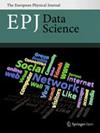合作作者网络中的隔离结构及其对科学成果的影响
IF 2.5
2区 计算机科学
Q1 MATHEMATICS, INTERDISCIPLINARY APPLICATIONS
引用次数: 0
摘要
共同作者网络是理解学术界知识生产和传播的关键,节点代表作者,边缘代表共同作者关系。社会结构、偏见(隐性和显性)和约束(如空间、时间)影响着谁与谁合作,并导致合著网络组织成具有不同程度隔离的紧密社区。我们的目标是研究导致隔离的共同作者网络结构的各个方面及其对科学生产的影响。我们使用光谱隔离指数(SSI)测量隔离,并找到四个有序的类别:完全隔离,高度隔离,适度隔离和非隔离社区。我们将注意力集中在非隔离和高度隔离的社区,量化和比较它们的结构拓扑和k -核心位置。当考虑这两个类别的群落(控制大小)时,我们的结果显示密度和聚类没有差异,但核心位置有很大的变化。较大的非隔离社区更有可能占据靠近网络核心的核心,而高度隔离的社区往往更靠近网络外围。最后,我们分析了研究人员在不同隔离类别的群体中获得的引文差异。高度隔离社区的研究人员从中间核心的社区成员那里获得了更多的引用,而在中间/外围核心,每篇论文获得了更多的引用。那些在非种族隔离社区的人在核心群体中每篇文章得到更多的引用。据我们所知,这项工作是第一次描述共同作者网络中的社区隔离,并调查社区隔离与作者引用之间的关系。我们的研究结果有助于研究高度隔离的科学共同作者群体,并为干预策略铺平道路,以改善科学知识的增长和传播。本文章由计算机程序翻译,如有差异,请以英文原文为准。

The structure of segregation in co-authorship networks and its impact on scientific production
Abstract Co-authorship networks, where nodes represent authors and edges represent co-authorship relations, are key to understanding the production and diffusion of knowledge in academia. Social constructs, biases (implicit and explicit), and constraints (e.g. spatial, temporal) affect who works with whom and cause co-authorship networks to organise into tight communities with different levels of segregation. We aim to examine aspects of the co-authorship network structure that lead to segregation and its impact on scientific production. We measure segregation using the Spectral Segregation Index (SSI) and find four ordered categories: completely segregated, highly segregated, moderately segregated and non-segregated communities. We direct our attention to the non-segregated and highly segregated communities, quantifying and comparing their structural topologies and k -core positions. When considering communities of both categories (controlling for size), our results show no differences in density and clustering but substantial variability in the core position. Larger non-segregated communities are more likely to occupy cores near the network nucleus, while the highly segregated ones tend to be closer to the network periphery. Finally, we analyse differences in citations gained by researchers within communities of different segregation categories. Researchers in highly segregated communities get more citations from their community members in middle cores and gain more citations per publication in middle/periphery cores. Those in non-segregated communities get more citations per publication in the nucleus. To our knowledge, this work is the first to characterise community segregation in co-authorship networks and investigate the relationship between community segregation and author citations. Our results help study highly segregated communities of scientific co-authors and can pave the way for intervention strategies to improve the growth and dissemination of scientific knowledge.
求助全文
通过发布文献求助,成功后即可免费获取论文全文。
去求助
来源期刊

EPJ Data Science
MATHEMATICS, INTERDISCIPLINARY APPLICATIONS -
CiteScore
6.10
自引率
5.60%
发文量
53
审稿时长
13 weeks
期刊介绍:
EPJ Data Science covers a broad range of research areas and applications and particularly encourages contributions from techno-socio-economic systems, where it comprises those research lines that now regard the digital “tracks” of human beings as first-order objects for scientific investigation. Topics include, but are not limited to, human behavior, social interaction (including animal societies), economic and financial systems, management and business networks, socio-technical infrastructure, health and environmental systems, the science of science, as well as general risk and crisis scenario forecasting up to and including policy advice.
 求助内容:
求助内容: 应助结果提醒方式:
应助结果提醒方式:


